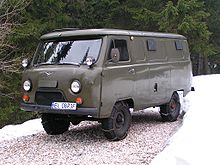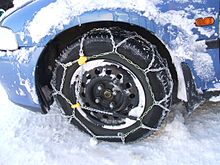Snow chains

Snow chains are a driving aid for vehicles on snow-covered roads and in muddy terrain , they are mounted on the tires . A distinction is made between full-fledged snow chains and starting aids.
Full-fledged snow chains form a network that is pulled over the treads of the tires. Depending on the arrangement of the chains, a further distinction is made between drive chains and track chains .
Drive chains prevent the wheels from spinning . They are mounted on the wheels of the drive axle (s) . The pieces of chain that are supposed to prevent the wheels from slipping run across the running surface.
Track chains are mounted on the wheels of the steering axle (s) and give the wheels a longitudinal guide to prevent them from slipping sideways. Here the main chain pieces run in the running direction.
Today, most of the chains used on cars or trucks are a combination of drive and track chains. The chain pieces run criss-cross across the running surface and are repeatedly connected with longitudinal pieces. Pure drive chains are mainly used on construction machines or tractors in forestry to bring wood.
The chain links are made of hardened steel , plastic, textiles or other materials. They are mostly angular to give better frictional resistance. Often there are still loose round chain links that are supposed to free the unwinding chain from sticking snow.
use
There are different views as to whether chains should be tightly tightened or loosely attached. While loose chains have better self-cleaning properties, tight chains damage the surface of the tire less. Since there is usually little space in the wheel arches, the chain is mounted rather taut.
Before attaching the chains, check whether there is enough space in the wheel arches. Not all vehicles allow chains to be fitted to standard size winter tires. This can lead to damage to sheet metal parts or the semi-axles.
With simple models, the chain is laid out lengthways in front of the respective tire. Then you have to run a little on the chain so that you can then put it around the tire and connect the two ends. The assembly is tedious for inexperienced users. This is why chain manufacturers are trying to simplify the process. With such chains, a springy steel ring is hung over the tire, then you drive a few centimeters to connect the outside of the chain. After assembly, drive a few meters and retighten the tensioning chain again.
In vehicles with ESP or ASR , snow chains may not be able to develop their full effect. The driving aids prevent the wheels from spinning too hard and thus prevent the chains from "digging" into the ground. It can therefore make sense, depending on the vehicle, to switch off ESP / ASR or to increase their intervention thresholds.
The maximum permissible speed for driving with chains is regulated by law in many countries. For example, the speed in Germany is limited to 50 km / h according to § 3 IV StVO , as well as in Switzerland and the Czech Republic. It is not regulated in Austria. However, speed restrictions by the chain manufacturer are also possible, which must be observed regardless of the regulations.
variants
Starting aids
Starting aids serve to overcome difficulties when starting up. They are only suitable for short distances (leaving a property or similar) after which you can continue driving without chains. In the case of cars, only brackets are mounted on the wheels as starting aid.
In the less common case of snow chains on motorcycles, u. a. special approach claws or belts are used.
Slingshot chains
Slingshot chains (technical name: rotation chain) are traction aids for vehicles on icy or snowy roads. They consist of several chain strands, one side of which is attached to rotating disks with a vertical axis of rotation (“chain wheel set”). These sprocket sets are mounted on the inside near the drive wheels. In poor road conditions, they are set in rotation so that the rotation of the chain wheel accelerates the chain pieces through centrifugal force on a circular path. As a result, they are constantly thrown from the front between the tire tread and the road. If the wheel then rolls onto the chains, there is greater friction and traction , as with snow chains . The rotor axis of the chains is rotated by approx. 45 ° towards the front of the vehicle. The directions of rotation on the left and right side of the vehicle must be opposite. When driving backwards, the directions of rotation must be reversed. Normally this is achieved by the fact that the sprocket sets of the centrifugal chains are driven directly in the form of a friction wheel drive from the tire flanks of the vehicle wheels - in principle like a bicycle side-rotor dynamo .
In the inactive state, the sprocket stands still and the chain strands hang loosely. Their length and the rest position of the sprocket sets are dimensioned so that the ends of the chain strands do not touch the roadway.
The advantage of sling chains is that they can usually be switched on and off from the driver's seat. This means they are immediately ready for use and just as quickly switched off again. This eliminates the need to stop to obstruct the traffic for the time-consuming installation and removal of conventional snow chains. However, sling chains do not replace the chains prescribed by traffic signs. If chains are required by law , only fully-fledged chains may be used.
Slingshot chains are mainly used in heavy commercial vehicles .
Motorcycle snow chains
Snow chains are rarely used on motorcycles. Snow chains can be used as an aid in winter to build up the desired traction , especially in the (more stable) combination operation .
Due to their relatively low distribution, snow chains for motorcycles are often self-made. But there are also a few isolated manufacturers of motorcycle snow chains.
Snow grab

A special form mainly on tracked vehicles in the military sector are snow grabs. Their metal crawlers are usually equipped with rubber pads without a profile. However, they offer little traction on smooth surfaces (ice, frozen snow). Therefore, some of the rubber pads can be replaced with metal grippers. When not in use, the snow grippers are usually attached to the outside of the vehicle in one or more rows.
Time of use and legal regulations

Trucks or buses that use local transport in the relevant regions are generally equipped with snow chains. Trolleybuses , on the other hand, are usually not equipped with snow chains due to safety considerations regarding insulation ; instead, several axles are driven and / or sand spreaders are used. The situation with long-distance traffic is also difficult , as the vehicles often do not carry chains and then have to accept either detours or waiting times until a route is free to drive again. Vehicles that need to be ready for use quickly, such as B. In the cold season , fire engines are usually parked in the garage with chains attached, because the chains can be removed faster than they can be put on.
So-called chain berths must be provided on motorways in front of sections for which chains may be mandatory. An example of this is the Vienna Outer Ring Motorway , which can sometimes only be used with chains, especially in the early morning hours after snowfall.
history
Snow chains are an invention of the American Harry D. Weed , to whom the US Patent Office issued a patent certificate on August 23, 1904.
Web links
Individual evidence
- ↑ http://www.rezulteo-reifen.de/autoreifen-guide/ihre-reifen-im-winter/wann-mussen-schneeketten-benutzt-haben-6514 Snow chain assembly
- ↑ Mandatory snow chains and regulations on the ÖAMTC portal accessed on April 24, 2018
- ↑ Description of the attachment of centrifugal chains on a manufacturer's website , accessed on January 31, 2015
- ↑ DIN EN 50502: Railway applications - Vehicles - Electrical equipment in trolley buses - Safety requirements and connection systems (2014)
- ↑ Verkehrsbetriebe Luzern: Annual report and accounts 1999 , p. 15
- ↑ Patent US768495 : Grip-Tread for Pneumatic Tires. Registered February 9, 1904 , published August 23, 1904 , inventor: Harry D. Weed.




